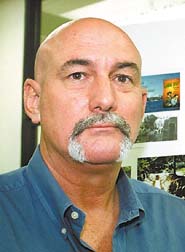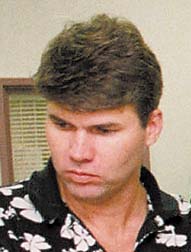


By Gregg K. Kakesako
Star-Bulletin
For nearly a year, behind a glass wall in a nondescript concrete building at Hickam Air Force Base, 19 work tables have held the skeletal remains of 19 Marines, including one believed to be the first enlisted Marine to be awarded the Medal of Honor in World War II.The bones are the focal point of almost six decades of mystery.
Now, the U.S. Army Central Identification Laboratory, the country's premiere forensic facility, is close to confirming that the remains are those of 19 members of the 2nd Marine Raider Battalion, who were killed in action on Aug. 17 and 18, 1942, during a raid on Makin Atoll, then part of the Gilbert Islands. Now known as Butaritari, the atoll today is part of the Republic of Kiribati.
The bones -- plus remains believed to be those of a South Pacific islander -- were found during an extensive recovery effort that began in 1998. It was the largest and the most significant recovery project undertaken by the Army lab since it was created in 1973.
The first Butaritari recovery mission was launched in August, 1998, and was followed by two others in November and December, 1999. The shallow mass grave was discovered on the northern shore of the island under a crushed coral road.

The Japanese had occupied the atoll's main island in December, 1941, after attacking Pearl Harbor. Butaritari Island is its most dominant land mass -- only about eight-tenths of a mile at its widest section and 18 miles long.In August, 1942, two companies of Marine Raiders, led by founder, Maj. Evans Carlson, were dispatched by rubber boats from the submarines Nautilus and Argonaut, which they had boarded at Pearl Harbor. In the predawn raid, 221 Marines attacked the Japanese garrison, destroying two seaplanes and killing 83 enemy soldiers. In a firefight, Sgt. Clyde Thomason was awarded the Medal of Honor after drawing the attention of Japanese soldiers in order to direct the fire of his platoon.
The attack was the first U.S. amphibious strike after Pearl Harbor in a location deep inside Japanese defenses, and it boosted morale on the homefront. However, it may have forced the Japanese to worry about the potential threat on its rear-area installations, further fortifying islands such as Tarawa.
Members of Makin Raiders had practiced amphibious landings in rubber boats off Oahu's Barbers Point, but the calm surf there was nothing like that they eventually experienced at Butaritari Island.
Brad Sturm, Central Identification Lab anthropologist, said Carlson paid an islander $50 to bury the 19 Marines, thinking that the rest of his unit had been evacuated to the submarines.

However, military records show that 12 other Marines did not make the beach rendezvous and were left behind. Three were captured a day later, on Aug. 19, 1942. It is not known if they were taken as prisoners or executed. The other nine were captured two weeks later and taken to Kwajalein, where they were executed.Hindering previous recovery efforts was the fact that the landscape of the tiny crescent-shape island had changed since the war. "Previous attempts in 1949 to recover the graves had been unsuccessful," Sturm said.
Another problem was that the military had built roads on the island during the war, including one right over the grave.
What finally led to the grave was not any modern-day technology, but the recollections of a 75-year-old man. Sturm, who was a member of the December expedition, happened to interview Tokerai Bureimo, who said he had helped bury the Marines when he was just 16 years old.
"He told us his father owned a well about 825 feet east of the ocean and that there was a cart path running near it to an old Japanese building," Sturm said.
Aided by an old man's memories, Sturm's team was led to within 16 feet of the mass grave, near a small village 300 yards from the end of the island's runway. A series of trenches, 3 feet by 40 to 50 feet, were dug around the site. One of the first trenches revealed the remains of a native islander, Sturm said.
"The next trench hit a helmet, but we were not able to determine if it was American or Japanese."
After two days of digging, more human remains were discovered.
Work then shifted to trowels and small whisk brooms. Sand and gravel were collected in buckets and sifted through filter screens.
Slowly revealed: bodies placed atop each other, three deep. Eventually, 20 sets of remains were uncovered, some with gear hanging from their skeleton, and removed intact.
At one point, ordnance specialists had to be called in to remove 55 live U.S. hand grenades. Also found were a rusty M-1 rifle, walkie talkies and dog tags.
On. Dec. 17, 1999, after more than 57 years in an unmarked grave, the remains of 19 Americans were escorted by a Marine color guard and put aboard a KC-130 Hercules aircraft and flown to Hickam Air Force Base.
As the remains were placed on the aircraft, Bureimo is said to have broken out in a chorus of the "Marine Corps Hymn."
Still unresolved is the final resting place of the nine Marines who were executed on Kwajalein. The Army hopes to return to that Pacific island sometime early next year to find out.


The son of a career Army officer, James Milton Jefferson always considered the military as a career, said his older brother, retired Maj. Gen. Wayne Jefferson.
James Jefferson graduated from the Air Force Academy at Colorado Springs in 1964.
"We both always had a interest in flying," Wayne Jefferson recalled. "We always went to air shows. Going into the military was a good thing. Since we both wanted to fly, the Air Force was the only way to go."
On May 12, 1967, 1st Lt. James Jefferson and Col. Norman C. Gaddis were part of a four-aircraft strike mission near Hoa Loc Airfield in Ha Son Binh Province near Hanoi in North Vietnam. Although trained as a pilot, Jefferson, then 25, was a back-seater, serving as a weapons system operator with Gaddis piloting their Phantom jet.
"He was flying out of Da Nang," his brother recalled. "His F-4 Phantom had been configured as an air combat aircraft. His mission was to fight MIGs."
Lt. Jefferson had been in South Vietnam for seven months and had flown close to 100 missions. "When you reach your 100th mission, they send you home," his brother said. "He already had orders for Albuquerque and a fighter test unit."

As the jets neared the target area, they ran into MIG-17 fighters and enemy missiles. Gaddis radioed that he was having problems with his jet's left afterburner. His plane fell out of formation with two MIGS tailing it. Moments later, the Phantom burst into flames.Both Gaddis and Jefferson were believed to have ejected from the plane, but only one parachute was seen. Gaddis was immediately captured by the Vietnamese, the first Air Force colonel taken prisoner in North Vietnam. Jefferson was reported missing in action.
Gaddis was debriefed in 1973 after he returned home during "Operation Homecoming." He said that, within a few hours of being captured, he was shown a name tag and other items belonging to Jefferson, whom he did not see bailing out.
Jefferson's status from missing in action to presumed killed in action was recorded on March 3, 1982. He posthumously had been promoted to lieutenant colonel while listed as missing in action.
In 1988, the first of seven site and excavation expeditions to the Ha Son Binh Province began.
Local informants told investigators of a U.S.-Soviet Republic of Vietnam investigative team that they observed an U.S. plane being pursued by a Vietnamese fighter, with the American jet bursting "into flames before crashing."
They recalled one crewman being captured after ejecting and remembered that the body of another was found near the crash site alongside a tangled parachute. His body was buried that night or early the next morning near the wreckage.
American and North Vietnamese officials returned to the site in January, 1989, and discovered that it had been leveled by heavy equipment to make way for a rice crop. No remains or personal effects were found.
In July, 1994, flooded roads prevented recovery teams from visiting the site. Other unsuccessful attempts followed in October that year. In November, 1996, small fragments of aircraft wreckage were uncovered. Following interviews with Vietnamese in November, 1997, and September, 1998, U.S. and North Vietnamese recovery teams returned to the crash site on Nov. 5, 1998.
There, during a one-month excavation, a single tooth was uncovered. It was sent to the Central Identification Lab at Hickam on Jan. 15, 1999.
Another excavation expedition was held from Feb. 23 to March 21, 1999, but no other remains were uncovered.
Then, on May 14, 1999, a recovery team working about 33 feet north of where North Vietnamese claimed to have found human remains several months earlier, revealed bone fragments. Those bones, plus those recovered by North Vietnamese in March, 1999, were sent to Hickam.
An Army dentist, Lt. Col. William Carmichael, was able to match Jefferson's dental records to the one left molar that was recovered. "There is no question it was his tooth," he said.
Carmichael said his efforts were made a lot easier, since he had dental X-rays of that exact molar. "I suspect the individual X-ray may have been taken back then because someone had planned to take it out," he said.
After the burial site was marked, Robert Mann, the Army's senior lab manager at Hickam, said recovery team members used screens and other archaeological techniques to pore through the soil for bone fragments and other personal effects.
Lab manager John Byrd, who did the anthropological part of the investigation, said large fragments of upper and lower leg bones were recovered, but the rest were very small bone fragments.
"When I started my analysis I didn't know who he was. I just started comparing information based on his bone structure to determine who he couldn't be ... It was easy to determine that he was too large to be a Vietnamese person," Byrd said.
The bones matched someone who was 6 feet tall. Other information indicated there had been no other American losses in the area.
Because no personal effects were ever recovered, "the cornerstone of the identification was the tooth," Carmichael said.
Following a memorial service at Arlington Cemetery on Oct. 16, Jefferson, who was awarded the Silver Star and the Distinguished Flying Cross with one Oak Leaf Cluster, was buried near his father and mother in Gainesville, Fla.
"It is now apparent Jim died on that day in May 1967," the family said in a written statement. "We are extremely grateful and relieved that his fate is now known for certain and that he has been returned home to the country that he loved and died for."
CILHI policy prevents photographs of remains from being published.
All bones and teeth photographed are replicas.